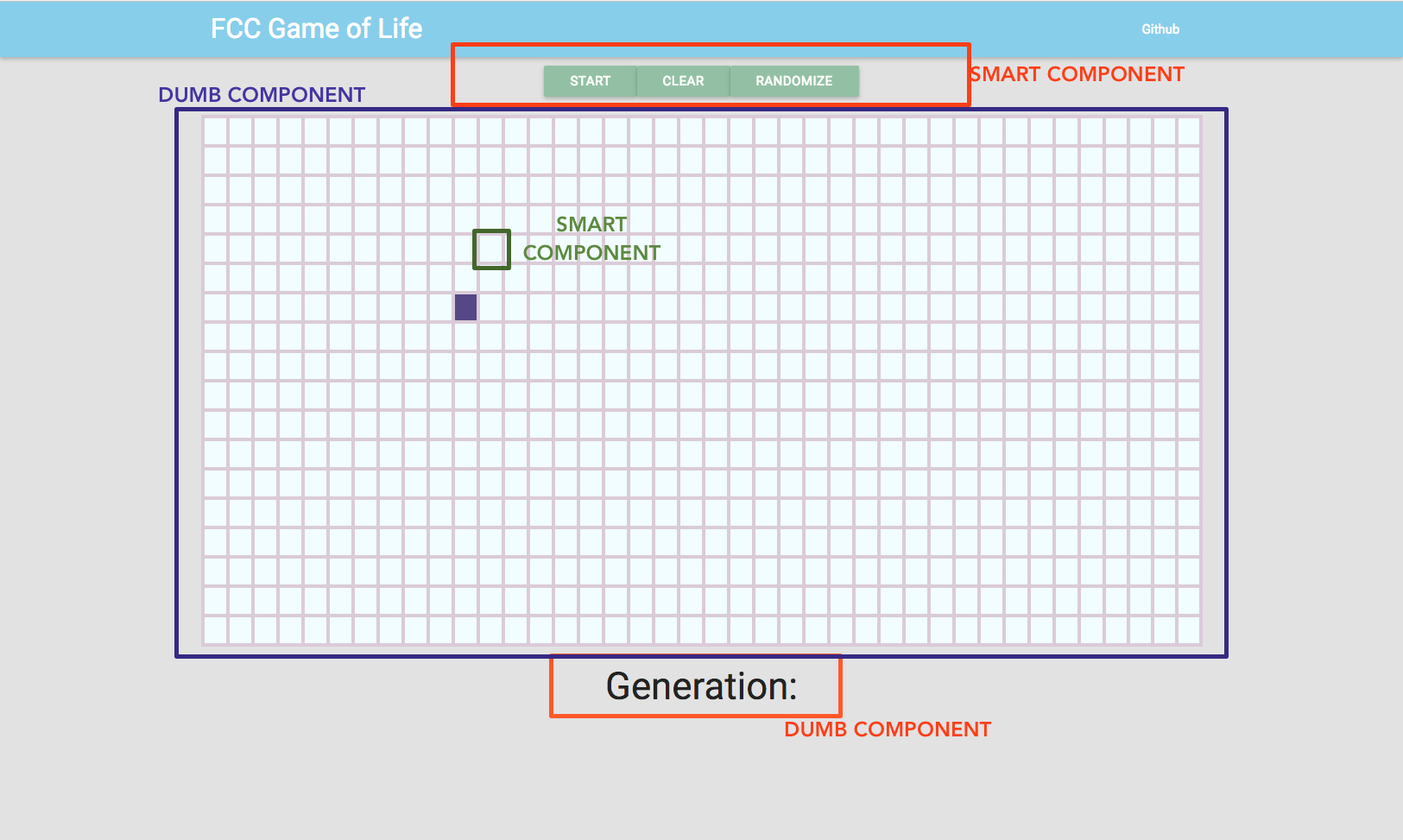- html - 出于某种原因,IE8 对我的 Sass 文件中继承的 html5 CSS 不友好?
- JMeter 在响应断言中使用 span 标签的问题
- html - 在 :hover and :active? 上具有不同效果的 CSS 动画
- html - 相对于居中的 html 内容固定的 CSS 重复背景?
目前我正在研究 Building Game of Life in FCC我认为这将是一个很好的项目来测试我对 React-Redux 的了解。
由于我是 Redux 的新手,我很难理解这个项目中什么是dumb组件和智能组件。
在我看来,这是我的看法: 
注意:当我说“智能组件”与“dumb组件”时,我的意思只是说,作为一个“智能组件”,它是一个容器,或者与应用程序状态相关的东西,而“dumb组件”只是意味着它的工作是简单地渲染任何它被喂养的东西。
如果我的假设是正确的,那么我很难在单元格上正确设置应用程序状态。
这是我到目前为止写的内容:
component/board.js
import React, { Component } from 'react';
import Cell from '../containers/cell'
export default class Board extends Component {
constructor(props){
super(props);
this.state = {height: 18, width: 40}
this.test = this.test.bind(this)
}
test(){
console.log(this.state)
}
render(){
let rows = [];
for (var i = 0; i < this.state.height; i++){
let rowID = `row${i}`
let bin = []
for (var idx = 0; idx < this.state.width; idx++){
let cellID = `cell${i}-${idx}`
bin.push(<Cell key={cellID} id={cellID}/>)
}
rows.push(<tr key={i} id={rowID}>{bin}</tr>)
}
return(
<div className="container">
<div className="row">
<div className="col s12 board"></div>
<table id="simple-board">
<tbody>
{rows}
</tbody>
</table>
</div>
</div>
)
}
}
container/cell.js
import React, { Component } from 'react';
// import from '../actions/index';
// import { connect } from 'react-redux';
// import { bindActionCreators } from 'redux';
export default class Cell extends Component{
constructor(props){
super(props);
this.state = {
color: 'dead'
};
this.test = this.test.bind(this);
}
test(){
this.state.color === 'dead' ? this.setState({color:'alive'}) : this.setState({color:'dead'})
}
render(){
return (
<td
className={this.state.color}
key={this.props.cellID}
id={this.props.cellID}
onClick={this.test}>
</td>
)
}
}
// function mapDispatchToProps(dispatch){
// return bindActionCreators({}, dispatch)
// }
// export default connect(null,mapDispatchToProps)()
我不确定此时我该如何处理。起初我想过必须将所有单元格包装在一个数组中,这将是应用程序的状态,但我不确定如何继续。
任何回应将不胜感激
最佳答案
我建议您按照这样的层次结构。我将把组件层次结构表示为类似 JSON 的语法,以便您能够理解:
App (smart) {
dispatchProps: {
...gameControlActions, // gets passed into GameControls
onCellClick, // gets passed down to Board, and then to each Cell
}
stateProps: {
cells: [{
id: #
status: 'dead', // or 'alive'
}], // gets passed down to Board, to render cells
...generationData, // gets passed down to Generation
}
}
// Children of App
GameControls (dumb) // start, clear, randomize
Board (dumb)
Cells (dumb)
Generation (dumb)
当你渲染单元格时,你会像这样渲染它们:
<Cell key={cellID} id={cellID} status={status} onClick={this.props.onCellClick} />
在 Cell 组件中,render 函数看起来像这样,您现在可以去掉 state:
render(){
return (
<td
className={this.props.status}
id={this.props.id}
onClick={this.props.onClick.bind(null, this.props.id)}>
</td>
)
}
您的 onCellClick 操作看起来像这样:
function onCellClick(cellId) {
return {
type: 'CELL_CLICK',
payload: cellId,
};
}
然后,您将通过切换单元格数组中该单元格的 status 来处理 reducer 中的该操作(请记住返回 cells 的新副本)。此外,如有必要,您可能需要使 Cell 组件扩展 PureComponent,以加快协调过程或实现 shouldComponentUpdate .
如果这没有意义,或者您有任何疑问(我想您会的),请告诉我。
关于javascript - 使用 React-Redux 的生命游戏,我们在Stack Overflow上找到一个类似的问题: https://stackoverflow.com/questions/39499480/
我有一个 html 格式的表单: 我需要得到 JavaScript在value input 字段执行,但只能通过表单的 submit .原因是页面是一个模板所以我不控制它(不能有
我管理的论坛是托管软件,因此我无法访问源代码,我只能向页面添加 JavaScript 来实现我需要完成的任务。 我正在尝试用超链接替换所有页面上某些文本关键字的第一个实例。我还根据国家/地区代码对这些
我正在使用 JS 打开新页面并将 HTML 代码写入其中,但是当我尝试使用 document.write() 在新页面中编写 JS 时功能不起作用。显然,一旦看到 ,主 JS 就会关闭。用于即将打开的
提问不是为了解决问题,提问是为了更好地理解系统 专家!我知道每当你将 javascript 代码输入 javascript 引擎时,它会立即由 javascript 引擎执行。由于没有看过Engi
我在一个文件夹中有两个 javascript 文件。我想将一个变量的 javascript 文件传递到另一个。我应该使用什么程序? 最佳答案 window.postMessage用于跨文档消息。使
我有一个练习,我需要输入两个输入并检查它们是否都等于一个。 如果是 console.log 正则 console.log false 我试过这样的事情: function isPositive(fir
我正在做一个Web应用程序,计划允许其他网站(客户端)在其页面上嵌入以下javascript: 我的网络应用程序位于 http://example.org 。 我不能假设客户端网站的页面有 JQue
目前我正在使用三个外部 JS 文件。 我喜欢将所有三个 JS 文件合而为一。 尽一切可能。我创建 aio.js 并在 aio.js 中 src="https://code.jquery.com/
我有例如像这样的数组: var myArray = []; var item1 = { start: '08:00', end: '09:30' } var item2 = {
所以我正在制作一个 Chrome 扩展,它使用我制作的一些 TamperMonkey 脚本。我想要一个“主”javascript 文件,您可以在其中包含并执行其他脚本。我很擅长使用以下行将其他 jav
我有 A、B html 和 A、B javascript 文件。 并且,如何将 A JavaScript 中使用的全局变量直接移动到 B JavaScript 中? 示例 JavaScript) va
我需要将以下整个代码放入名为 activate.js 的 JavaScript 中。你能告诉我怎么做吗? var int = new int({ seconds: 30, mark
我已经为我的 .net Web 应用程序创建了母版页 EXAMPLE1.Master。他们的 I 将值存储在 JavaScript 变量中。我想在另一个 JS 文件中检索该变量。 示例1.大师:-
是否有任何库可以用来转换这样的代码: function () { var a = 1; } 像这样的代码: function () { var a = 1; } 在我的浏览器中。因为我在 Gi
我收到语法缺失 ) 错误 $(document).ready(function changeText() { var p = document.getElementById('bidp
我正在制作进度条。它有一个标签。我想调整某个脚本完成的标签。在找到可能的解决方案的一些答案后,我想出了以下脚本。第一个启动并按预期工作。然而,第二个却没有。它出什么问题了?代码如下: HTML:
这里有一个很简单的问题,我简单的头脑无法回答:为什么我在外部库中加载时,下面的匿名和onload函数没有运行?我错过了一些非常非常基本的东西。 Library.js 只有一行:console.log(
我知道 javascript 是一种客户端语言,但如果实际代码中嵌入的 javascript 代码以某种方式与在控制台上运行的代码不同,我会尝试找到答案。让我用一个例子来解释它: 我想创建一个像 Mi
我如何将这个内联 javascript 更改为 Unobtrusive JavaScript? 谢谢! 感谢您的回答,但它不起作用。我的代码是: PHP js文件 document.getElem
我正在寻找将简单的 JavaScript 对象“转储”到动态生成的 JavaScript 源代码中的最优雅的方法。 目的:假设我们有 node.js 服务器生成 HTML。我们在服务器端有一个对象x。

我是一名优秀的程序员,十分优秀!